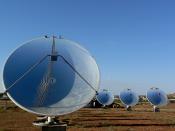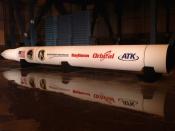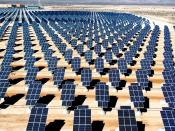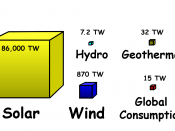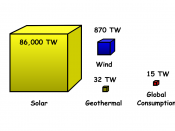The Sun is an abundant energy resource, the energy from which is available on Earth in the form of electromagnetic radiation. The center of our Solar System fuels most types of our "renewable" energy resources. The simplest use of the Sun is to merely place something in the path of incident sunlight to increase its temperature "ÃÂ the average kinetic energy of the particles in motion in a body. With the aid of some clever engineering, together with common-sense engineering, the passive heating effect of the Sun can be used sucessfully and economically as an energy source. The amuont of energy available per location is relatively small, and this limitation is likely to remain in the future. In some applications, however, it is the most economical alternative; and, of course, solar energy will be available for another five billion years! Solar power is energy from the sun. This energy is produced through nuclear fussion. This energy then travels 93 million miles in the form of photons. These photons carry energy at a rate about 1*10 Megawatts to the Earth's surface. In order to not disturb the environment by utilizing this energy, only about one percent of this energy can be used. That is 1*10 megawatts, and over a course of a year that would equal nearly 30,000 Quadrillion BTU's. With the world use of energy only about 350 Quads, this is about 85 times as much energy as the world needs. In the U.S., residential space heating requires about 5.33 Quads of energy a year. Hot water production for commerical and residential requires nearly another quad of energy. Though proper building design and the use of some solar collecting technology, much of this energy need could be eliminated.
The Sun is an abundant energy resource, the energy from which is available on Earth in the form of electromagnetic radiation. The center of our Solar System fuels most types of our "renewable" energy resources. The simplest use of the Sun is to merely place something in the path of incident sunlight to increase its temperature "ÃÂ the average kinetic energy of the particles in motion in a body. With the aid of some clever engineering, together with common-sense engineering, the passive heating effect of the Sun can be used sucessfully and economically as an energy source. The amuont of energy available per location is relatively small, and this limitation is likely to remain in the future. In some applications, however, it is the most economical alternative; and, of course, solar energy will be available for another five billion years! Solar power is energy from the sun. This energy is produced through nuclear fussion. This energy then travels 93 million miles in the form of photons. These photons carry energy at a rate about 1*10 Megawatts to the Earth's surface. In order to not disturb the environment by utilizing this energy, only about one percent of this energy can be used. That is 1*10 megawatts, and over a course of a year that would equal nearly 30,000 Quadrillion BTU's. With the world use of energy only about 350 Quads, this is about 85 times as much energy as the world needs. In the U.S., residential space heating requires about 5.33 Quads of energy a year. Hot water production for commerical and residential requires nearly another quad of energy. Though proper building design and the use of some solar collecting technology, much of this energy need could be eliminated.
The Sun is an abundant energy resource, the energy from which is available on Earth in the form of electromagnetic radiation. The center of our Solar System fuels most types of our "renewable" energy resources. The simplest use of the Sun is to merely place something in the path of incident sunlight to increase its temperature "ÃÂ the average kinetic energy of the particles in motion in a body. With the aid of some clever engineering, together with common-sense engineering, the passive heating effect of the Sun can be used sucessfully and economically as an energy source. The amuont of energy available per location is relatively small, and this limitation is likely to remain in the future. In some applications, however, it is the most economical alternative; and, of course, solar energy will be available for another five billion years! Solar power is energy from the sun. This energy is produced through nuclear fussion. This energy then travels 93 million miles in the form of photons. These photons carry energy at a rate about 1*10 Megawatts to the Earth's surface. In order to not disturb the environment by utilizing this energy, only about one percent of this energy can be used. That is 1*10 megawatts, and over a course of a year that would equal nearly 30,000 Quadrillion BTU's. With the world use of energy only about 350 Quads, this is about 85 times as much energy as the world needs. In the U.S., residential space heating requires about 5.33 Quads of energy a year. Hot water production for commerical and residential requires nearly another quad of energy. Though proper building design and the use of some solar collecting technology, much of this energy need could be eliminated.

